[Learn photography] Die Blende - The aperture (DE/EN)
Hallo zusammen,
Vorwort / Foreword
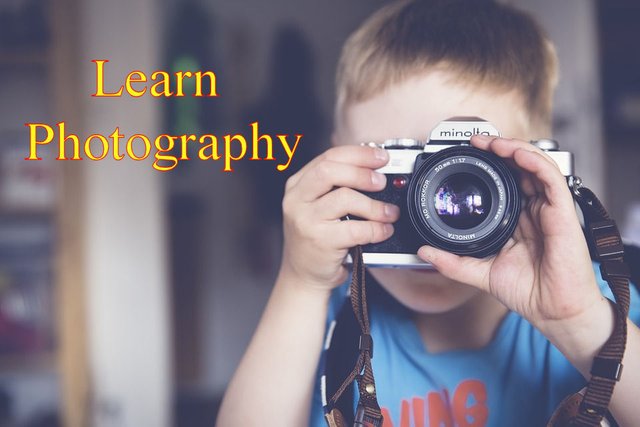
Quelle: https://pixabay.com/
ich mache heute eine neue Kategorie bei mir auf, das hatte ich schon etwas länger vorgehabt und ich bin schon gespannt wie es bei euch ankommt.
I make today a new category on me, I had already intended something longer and I'm already curious how it is received by you.
Die Blende / The aperture
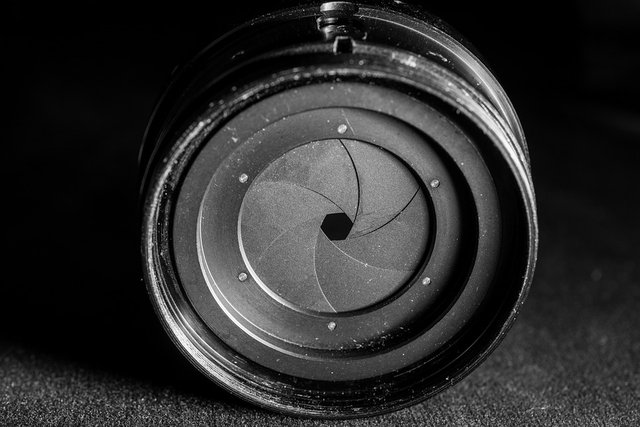
Quelle: https://pixabay.com/
Die Blende ist eine verstellbare Öffnung am Objektive, hier durch wird die Stärke des Lichtes gesteuert, die auf den Sensor trifft. Durch Einsatz von beweglichen Lamellen ist die Verstellung möglich, hierbei kann die Anzahl der Lamellen von Herstellern unterschiedlich sein. Eine Blende kann auch für Effekte eingesetzt werde, wie zum Beispiel ein Blendenstern. Auf dem Objektive wird dieser Wert mit f 1:xx oder f/xx angegeben.
The aperture is an adjustable opening on the lens that controls the strength of the light that hits the sensor. The adjustment is possible through the use of movable blades, the number of blades can vary from manufacturer to manufacturer. An aperture can also be used for effects, such as an aperture star. On the lens, this value is indicated as f 1:xx or f/xx.
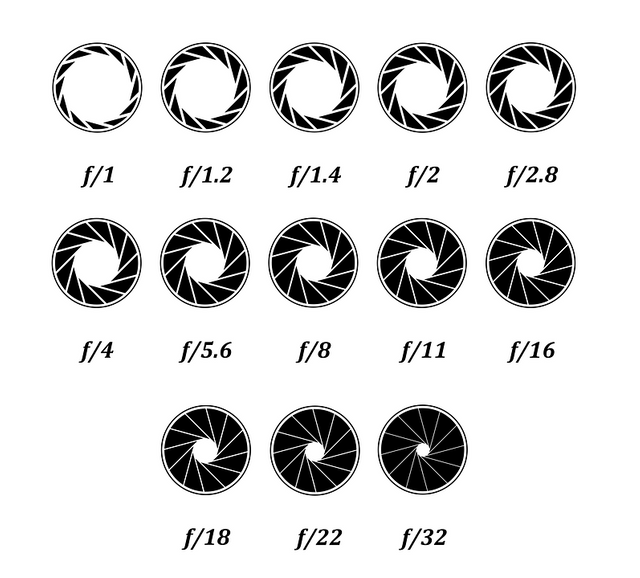
Quelle: https://pixabay.com/
Offenblende / Open aperture
Eine Offenblende bezeichnet man, wenn die Blende weit offen ist und sehr viel Licht auf den Sensor fällt. Durch mehr Licht verkürzt sich die Belichtungszeit. Hierbei ist die Zahl klein zum Beispiel f 1:2,8. Das lichtstärkste Objektiv für die Fotografie hat eine wert von f 1:0,7
An open aperture is when the aperture is wide open and a lot of light falls on the sensor. More light shortens the exposure time. Here the number is small, for example f 1:2.8. The fastest lens for photography has a value of f 1:0.7.
Geschlossene Blende / Closed aperture
Eine geschlossene Blende ist das Gegenteil von einer offenen Blende, hier wird nur sehr wenig Licht auf dem Sensor gelassen. Dadurch verlängert sich auch die Belichtungszeit. Der Blendenwert geht von f 1:11 hoch bis f 1:32 zum Beispiel.
A closed aperture is the opposite of an open aperture, here very little light is left on the sensor. This also increases the exposure time. The aperture value goes up from f 1:11 to f 1:32, for example.
Tiefenschärfe / Depth of focus
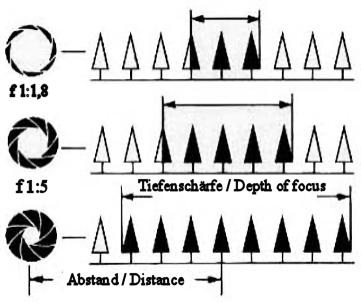
Die Blende steuer nicht nur das Licht, sondern auch die Tiefenschärfe.
Das heiß, welcher Bereich wird scharf und wie viel. Diese ergibt sich aus einer offenen Blende und einer geschlossener Blende. Bei der Porträtfotografie wird dieses viel genutzt. Hier wird die Person mit einer offenen Blende fotografiert, damit wird sie scharf dargestellt und der Vorder- und Hintergrund wird unscharf, das wird als Bokeh Effekt bezeichnet. Wobei eine durch gängige Tiefenschärfe mit einer geschlossener Blende erreicht wird. Das wird zum Beispiel bei der Landschaftsfotografie genutzt. Das heißt je weiter ich die Blende schließe, des so mehr Tiefenschärfe erreiche ich. Ganz wichtig ist auch der Abstand zum Objekt, je dicht ich dran bin so stärker tritt der Effekt auf. Das gilt auch für Brennweite, je dichter ich mir das Objekt ran Zoome des so größer tritt dieser Effekt mit der Tiefenschärfe auf.
The aperture controls not only the light, but also the depth of field.
That is, which area becomes sharp and how much. This results from an open aperture and a closed aperture. In portrait photography, this is used a lot. Here, the person is photographed with an open aperture, so he or she is in focus and the foreground and background are blurred, this is called the bokeh effect. Whereas a through common depth of field is achieved with a closed aperture. This is used for example in landscape photography. That is, the further I close the aperture, the more depth of field I achieve. The distance to the object is also very important; the closer I am, the stronger the effect. This also applies to the focal length, the closer I zoom in on the object, the greater the effect of depth of field.
Beugungsunschärfe / Diffraction blur
Eine Beugungsunschärfe entsteht bei geschlossen Blende und tritt meistens am Rand auf. Am Rand wird das Licht so weit gebeugt, dass es eine Unschärfe ergibt und somit die Tiefenschärfe wieder aufgehoben wird. Ab welche Blendenzahl das auftritt, ist von Herstellern des Objektives unterschiedlich.
Diffraction blur occurs when the aperture is closed and usually occurs at the edge. At the edge, the light is diffracted to such an extent that it results in a blur and thus the depth of field is cancelled out again. The f-number from which this occurs varies from lens manufacturer to lens manufacturer.
Blendensterne / Aperture stars
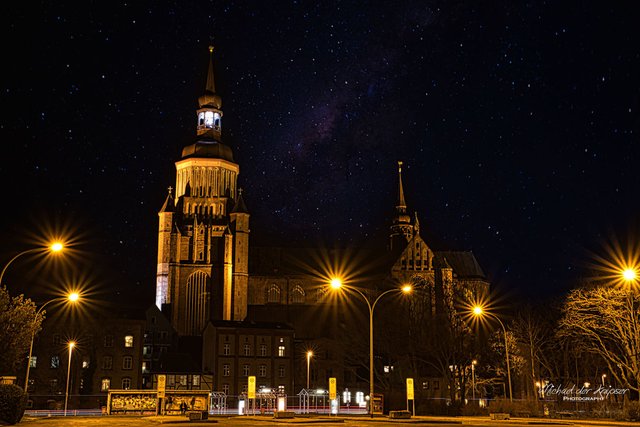
(46 mm; f/16; 30 sek.; ISO 160)
Kamera: Nikon D750, Objektive: Tamron 24-70 mm f2.8
Eine Blende besteht aus vielen Lamellen, die fächerförmig angeordnet sind, somit kann auch die Öffnung gesteuert werden. Durch das Schließen der Blende wird das Licht an den überschneiden Lamellen gebrochen. Dieses Licht fällt auf den Sensor und ein Blendenstern entsteht. Ab ungefähr Blende f 1:13 und höher tritt dieser Effekt auf. Durch die Bauart und Anzahl der Lamellen im Objektive, werden bei unterschiedlichen Objektive die Blendsterne nicht gleich aussehen.
An iris consists of many slats arranged in a fan shape, thus the opening can also be controlled. By closing the aperture, the light is refracted at the overlapping slats. This light falls on the sensor and an aperture star is created. From about aperture f 1:13 and higher, this effect occurs. Due to the design and number of blades in the lens, the aperture stars will not look the same with different lenses.

Ich hoffe, es war leicht verständlich, die einzelnen Beiträge bauen aufeinander auf und ich werde versuchen das Wissen allgemein zu vermitteln.
Wenn es euch gefallen hat, lasst doch gerne eine Vote da. Sollte Ihr Fragen haben, dann stellt sie doch bitte in die Kommentare und ich werde versuchen diese zu beantworten. Bis dahin wünsche ich euch einen schönen Tag.
I hope it was easy to understand, the individual contributions build on each other and I will try to convey the knowledge in general.
If you liked it, please leave a vote. If you have any questions, please post them in the comments and I will try to answer them. Until then I wish you a nice day.
Euer Hornet on Tour
DIG VALIDATOR: Hornet_on_Tour
Instagram: https://www.instagram.com/hornet_on_tour/
Twitter: https://twitter.com/OnHornet
Translated with www.DeepL.com/Translator (free version)
@tipu curate
Excelente iniciativa
Upvoted 👌 (Mana: 0/7) Get profit votes with @tipU :)
Thank you